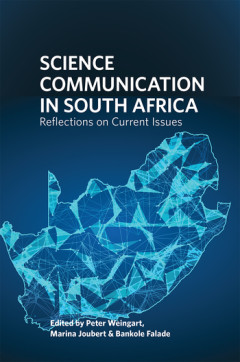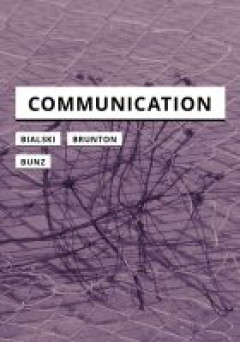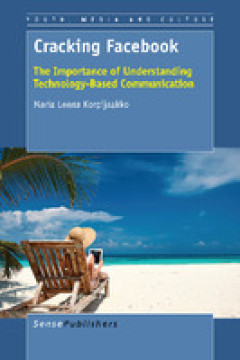Ditapis dengan

Re-engineering the uptake of ICT in schools
This book reports on a novel and comprehensive approach to the uptake of ICT in Schools. It focuses on key questions, pedagogically sound ways of introducing ICT, new technical artifacts supporting the approach, the evaluation in a large-scale validator, and future work. While many innovations in Technology Enhanced Learning (TEL) have emerged over the last two decades, the uptake of these inno…
- Edisi
- -
- ISBN/ISSN
- 9783319193663
- Deskripsi Fisik
- xvii, 201p. : ill.
- Judul Seri
- -
- No. Panggil
- 371.334 REE r

Critical theory of communication :new readings of Lukács, Adorno, Marcuse, H…
"This book contributes to the foundations of a critical theory of communication as shaped by the forces of digital capitalism. One of the world's leading theorists of digital media Professor Christian Fuchs explores how the thought of some of the Frankfurt School’s key thinkers can be deployed for critically understanding media in the age of the Internet. Five essays that form the heart of th…
- Edisi
- -
- ISBN/ISSN
- 9781911534075
- Deskripsi Fisik
- iv, 230p. : ill.
- Judul Seri
- -
- No. Panggil
- 301.01 FUC c

Science communication in South Africa :reflections on current issues
"Why do we need to communicate science? Is science, with its highly specialised language and its arcane methods, too distant to be understood by the public? Is it really possible for citizens to participate meaningfully in scientific research projects and debate? Should scientists be mandated to engage with the public to facilitate better understanding of science? How can they best communicate …
- Edisi
- -
- ISBN/ISSN
- 9781928502050
- Deskripsi Fisik
- iv, 231p. : ill.
- Judul Seri
- -
- No. Panggil
- 001.4028558 SCI s

Cyberpragmatics :internet-mediated communication in context
Cyberpragmatics is an analysis of Internet-mediated communication from the perspective of cognitive pragmatics. It addresses a whole range of interactions that can be found on the Net: the web page, chat rooms, instant messaging, social networking sites, 3D virtual worlds, blogs, videoconference, e-mail, Twitter, etc. Of special interest is the role of intentions and the quality of interpretati…
- Edisi
- -
- ISBN/ISSN
- 9789027256195
- Deskripsi Fisik
- xic, 353p. : ill.
- Judul Seri
- -
- No. Panggil
- 401.450285 YUS c

Risk Communication for the Future :Towards Smart Risk Governance and Safety M…
The conventional approach to risk communication, based on a centralized and controlled model, has led to blatant failures in the management of recent safety related events. In parallel, several cases have proved that actors not thought of as risk governance or safety management contributors may play a positive role regarding safety. Building on these two observations and bridging the gap betwee…
- Edisi
- -
- ISBN/ISSN
- 9783319740980
- Deskripsi Fisik
- -
- Judul Seri
- -
- No. Panggil
- 363.1 BOU t

Commercial communication in the digital age
In today’s digital age, online and mobile advertising are of growing importance, with advertising no longer bound to the traditional media industry. Although the advertising industry still has broader access to the different measures and channels, users and consumers today have more possibilities to publish, get informed or communicate – to “co-create” –, and to reach a bigger audienc…
- Edisi
- -
- ISBN/ISSN
- 9783110416794
- Deskripsi Fisik
- viii, 270p.: ill.
- Judul Seri
- -
- No. Panggil
- 302.2309 SIG c

Communication and content
Communication and content presents a comprehensive and foundational account of meaning based on new versions of situation theory and game theory. The literal and implied meanings of an utterance are derived from first principles assuming little more than the partial rationality of interacting agents. New analyses of a number of diverse phenomena – a wide notion of ambiguity and content encomp…
- Edisi
- -
- ISBN/ISSN
- 9783961101993
- Deskripsi Fisik
- -
- Judul Seri
- -
- No. Panggil
- 340 PAR c

Interdisciplinary insights for digital touch communication
Communication is increasingly moving beyond ‘ways of seeing’ to ‘ways of feeling’. This Open Access book provides social design insights and implications for HCI research and design exploring digitally mediated touch communication. It offers a socially orientated map to help navigate the complex social landscape of digitally mediated touch for communication: from everyday touch-screens,…
- Edisi
- -
- ISBN/ISSN
- 9783030245641
- Deskripsi Fisik
- -
- Judul Seri
- -
- No. Panggil
- 004.77 JEW i

Internationalizing "international communication"
A critical intervention in international communications, in which an array of eminent scholars challenge the Western-dominated conceptions of the field
- Edisi
- -
- ISBN/ISSN
- 9780472072446
- Deskripsi Fisik
- vi, 332p. : ill
- Judul Seri
- -
- No. Panggil
- 302.2 INT i

Social networks with rich edge semantics
Social Networks with Rich Edge Semantics introduces a new mechanism for representing social networks in which pairwise relationships can be drawn from a range of realistic possibilities, including different types of relationships, different strengths in the directions of a pair, positive and negative relationships, and relationships whose intensities change with time. For each possibility, the …
- Edisi
- -
- ISBN/ISSN
- 9781315390628
- Deskripsi Fisik
- xx, 210p. : ill.
- Judul Seri
- -
- No. Panggil
- 302.3015118 ZHE s

Communicative Figurations :Transforming Communications in Times of Deep Media…
This open access volume is about how to research the influence of our changing media environment. Today, there is not one single medium that is the driving force of change. With the spreading of various technical communication media such as mobile phone and internet platforms, we are confronted with a media manifold of deep mediatization. But how can we investigate its transformative capability…
- Edisi
- -
- ISBN/ISSN
- 9783319655840
- Deskripsi Fisik
- XXIII, 444 p.
- Judul Seri
- -
- No. Panggil
- 302.23 COM c

Information structure in Isthmus Zapotec narrative and conversation
This book presents an in-depth description of information structure in Isthmus Zapotec, an Otomanguean language spoken by around 50,000 people in southeastern Oaxaca, Mexico, and represents the first book-length treatment of information structure in a Mesoamerican language. Three main observations motivate the study: Strong documentation and a relatively large and active speaker community creat…
- Edisi
- -
- ISBN/ISSN
- 9783961101290
- Deskripsi Fisik
- V, 1198 p.
- Judul Seri
- -
- No. Panggil
- 497.6882 BUE i

Material aspects of letter writing in the Graeco-Roman world, 500 BC-AD 300
Letter writing was widespread in the Graeco-Roman world, as indicated by the large number of surviving letters and their extensive coverage of all social categories. Despite a large amount of work that has been done on the topic of ancient epistolography, material and formatting conventions have remained underexplored, mainly due to the difficulty of accessing images of letters in the past. Tha…
- Edisi
- -
- ISBN/ISSN
- 9783110426953
- Deskripsi Fisik
- viii, 388 p.
- Judul Seri
- -
- No. Panggil
- 886.0109 SAR m

Communication
Contemporary communication puts us not only in conversation with one another but also with our machinery. Machine communication—to communicate not just via but also with machines—is therefore the focus of this volume. Diving into digital communications history, Finn Brunton brings to the fore the alienness of computational communication by looking at network timekeeping, automated trolling,…
- Edisi
- -
- ISBN/ISSN
- 9783957961464
- Deskripsi Fisik
- 136 p.; 22 cm.
- Judul Seri
- -
- No. Panggil
- 302.2 BIA c

Conversational writing :a multidimensional study of synchronous and supersync…
The author analyses computer chat as a form of communication. While some forms of computer-mediated communication (CMC) deviate only marginally from traditional writing, computer chat is popularly considered to be written conversation and the most “oral” form of written CMC. This book systematically explores the varying degrees of conversationality (“orality”) in CMC, focusing in partic…
- Edisi
- -
- ISBN/ISSN
- 9783631671535
- Deskripsi Fisik
- 352 p.; 22 cm
- Judul Seri
- -
- No. Panggil
- 003.54 CON c

Doing applied linguistics. Enabling transdisciplinary communication
How can students be empowered to communicate professionally – as translators, journalists and CCOs? How can professionals engaged in crucial language interactions do the same – pilots, nurses, lawyers and many others? This volume gives answers to these questions, providing insights into critical situations and good practices from many years of research and teaching in a practice-oriented, r…
- Edisi
- -
- ISBN/ISSN
- 9783110496604
- Deskripsi Fisik
- viii, 251 p.; 22 cm.
- Judul Seri
- -
- No. Panggil
- 418 DOI d

Communicative capacity :public encounters in participatory theory and practice
Participatory democracy has become an unshakable norm and its practice is widespread. Nowadays, public professionals and citizens regularly encounter each other in participatory practice to address shared problems. But while the frequency, pace and diversity of their public encounters has increased, communicating in participatory practice remains a challenging, fragile and demanding undertaking…
- Edisi
- -
- ISBN/ISSN
- 9781447318507
- Deskripsi Fisik
- X, 274 p.
- Judul Seri
- -
- No. Panggil
- 320.941 BAR c

Cracking facebook :the importance of understanding technology-based communica…
This book presents a Facebook study on members of the Cusp Generation, or those born before the “great digital divide” of 1995. This delineation allows for a discussion on the possible socio-cultural implications of Facebook use for people of all ages. Members of the Cusp Generation are in a unique position as “part digital natives” to easily acquire and use new media technologies, whil…
- Edisi
- -
- ISBN/ISSN
- 9789463002110
- Deskripsi Fisik
- IX, 153 p.
- Judul Seri
- -
- No. Panggil
- 370 LEE c

Transformative Communication Technologies:the accountability challenge (36th …
"This booklet documents the 36th Boehm-Bawerk Lecture, presented by Prof. Robin Mansell on October 31, 2017 as a ceremonial opening ceremony for the Institute of Media, Society and Communication at the Faculty of Social and Political Sciences. "
- Edisi
- -
- ISBN/ISSN
- 9783903187146
- Deskripsi Fisik
- 96p.: ill.
- Judul Seri
- -
- No. Panggil
- 070.4 MAN t

Context in communication:a cognitive view
Context is what contributes to interpret a communicative act beyond the spoken words. It provides information essential to clarify the intentions of a speaker, and thus to identify the actual meaning of an utterance. A large amount of research in Pragmatics has shown how wide-ranging and multifaceted this concept can be. Context spans from the preceding words in a conversation to the general kn…
- Edisi
- -
- ISBN/ISSN
- 9782889451425
- Deskripsi Fisik
- 242 p.; 22 cm.
- Judul Seri
- -
- No. Panggil
- 302 AIR c
 Karya Umum
Karya Umum  Filsafat
Filsafat  Agama
Agama  Ilmu-ilmu Sosial
Ilmu-ilmu Sosial  Bahasa
Bahasa  Ilmu-ilmu Murni
Ilmu-ilmu Murni  Ilmu-ilmu Terapan
Ilmu-ilmu Terapan  Kesenian, Hiburan, dan Olahraga
Kesenian, Hiburan, dan Olahraga  Kesusastraan
Kesusastraan  Geografi dan Sejarah
Geografi dan Sejarah